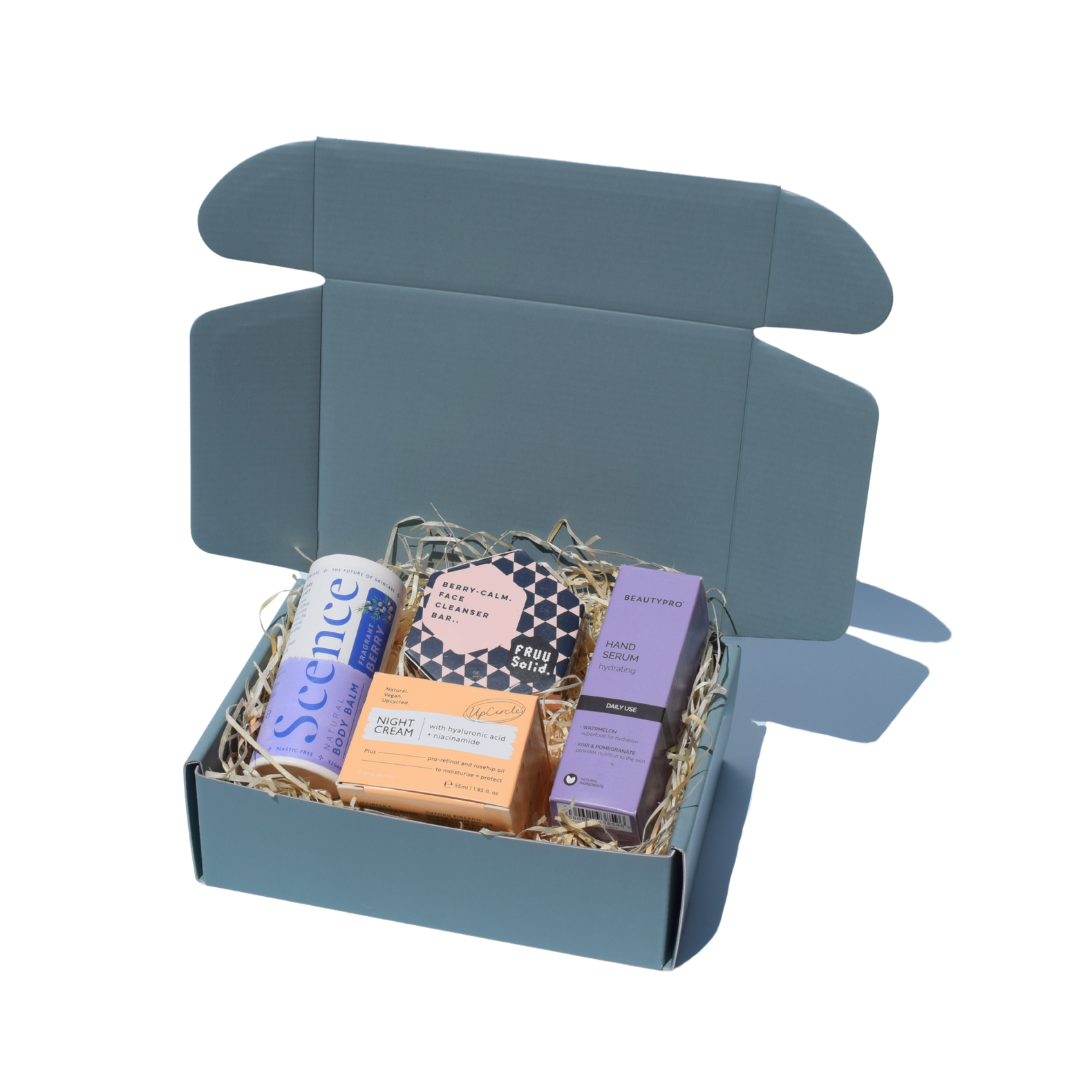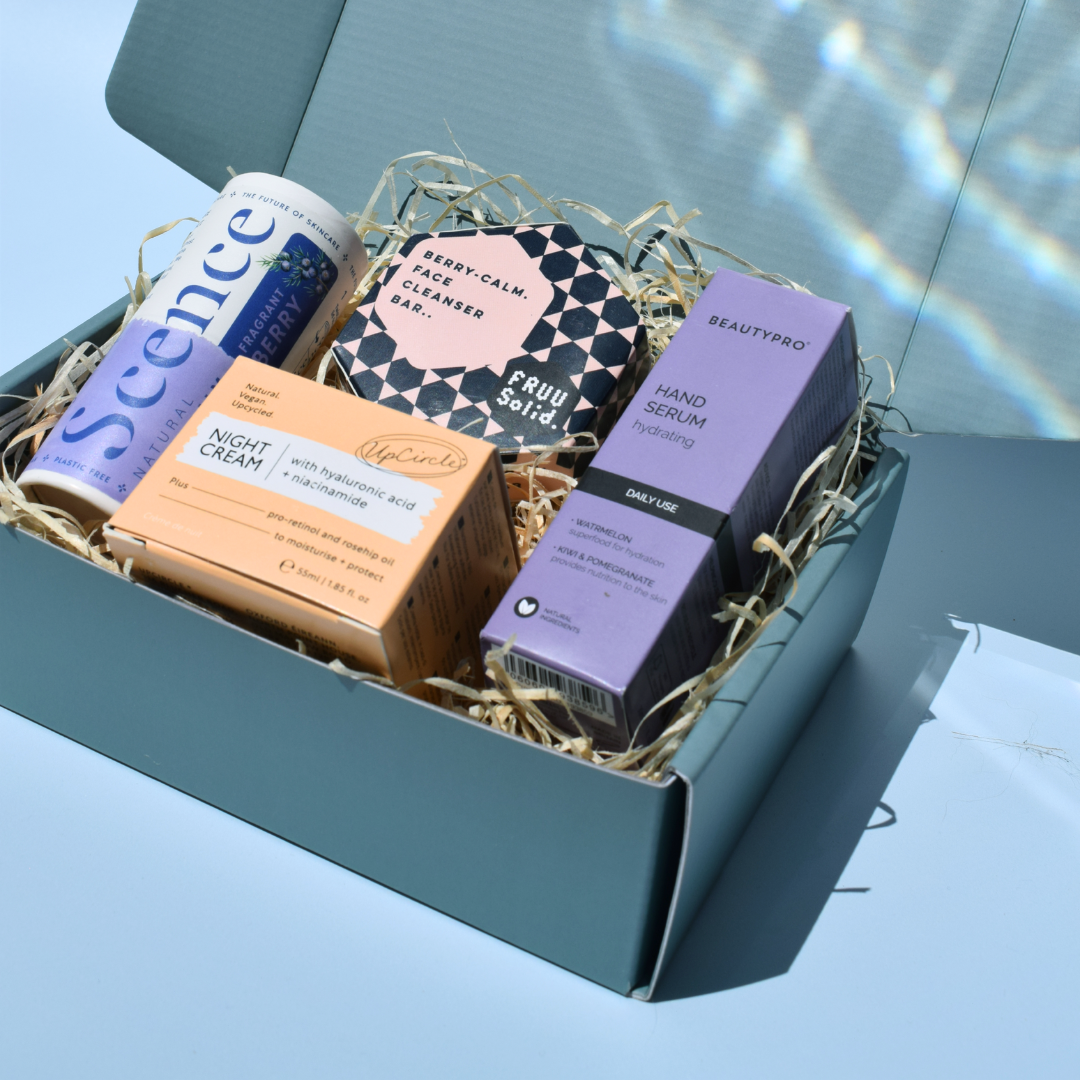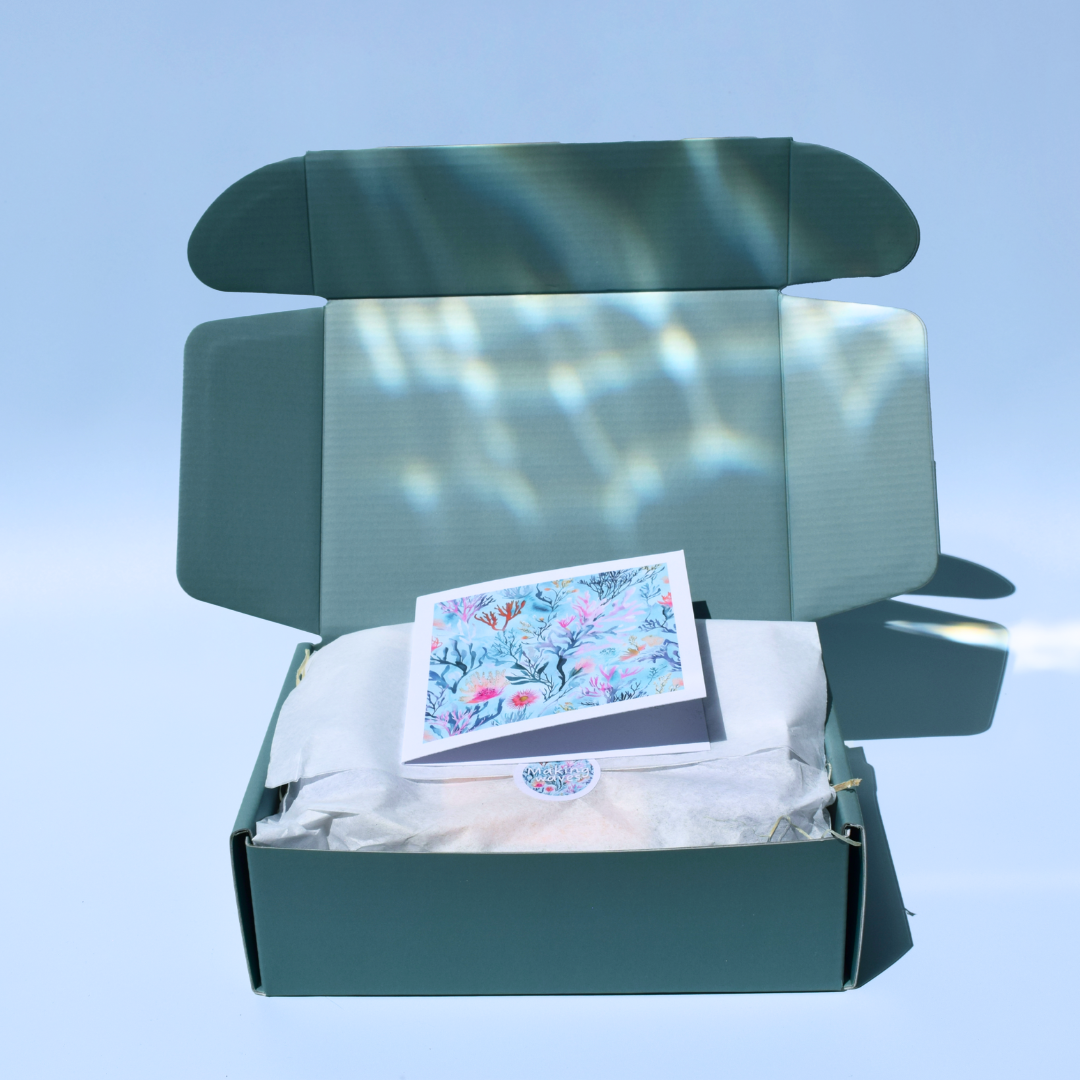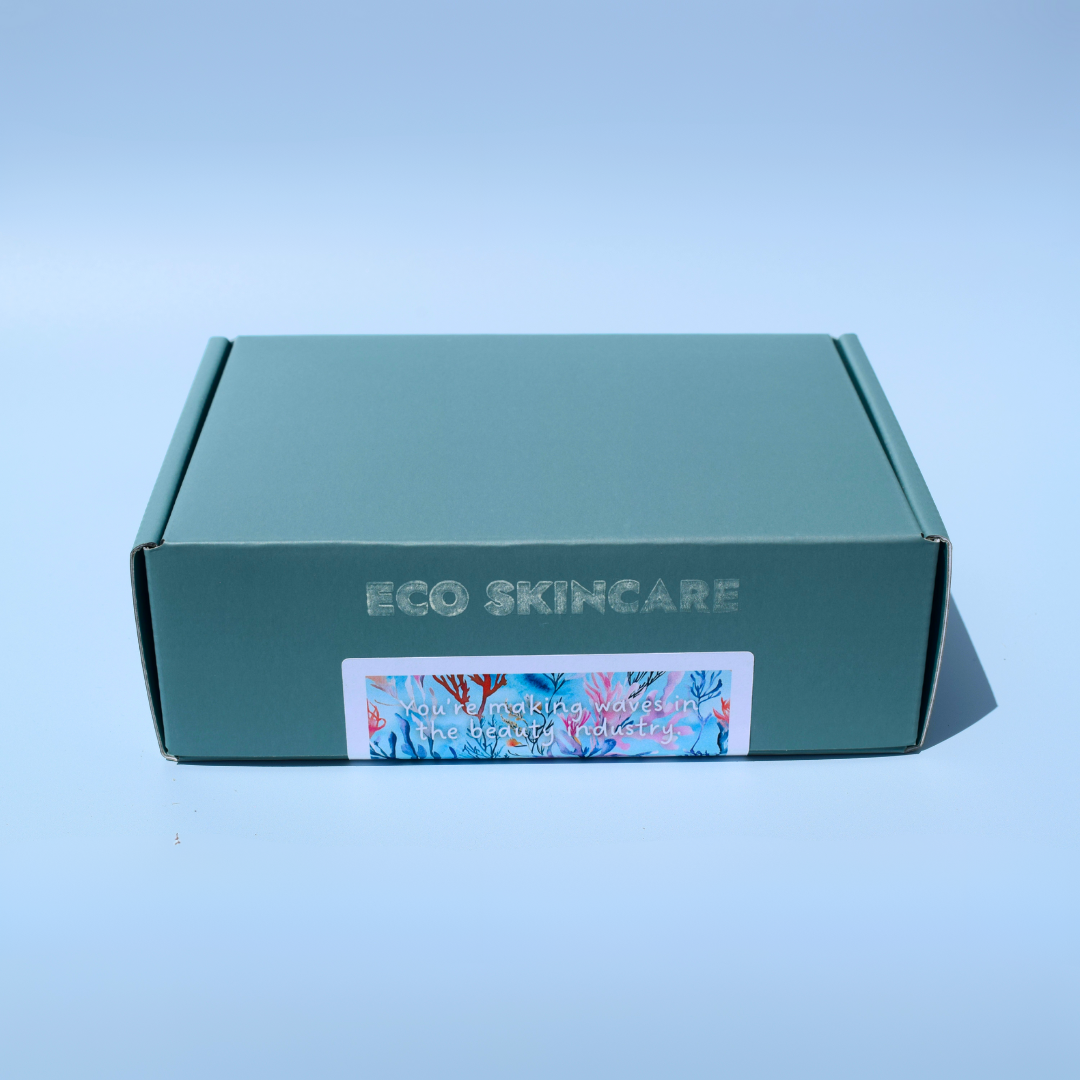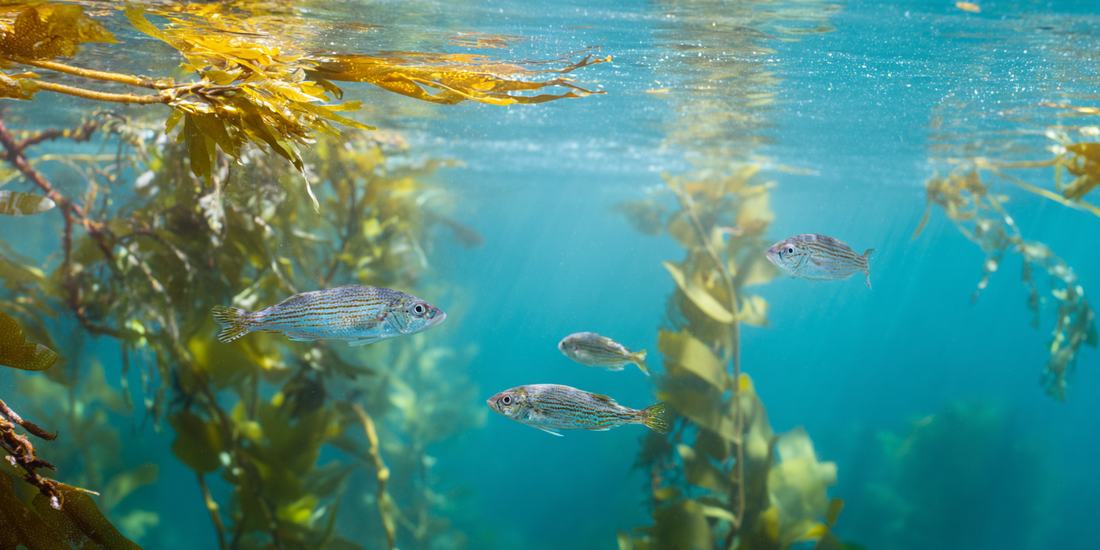
From Seabed to Screen: How Sussex Underwater's Story Inspires the Blue Beauty Movement
Share
Picture this: a 74-year-old free-diver descends into Sussex waters and comes face-to-face with a majestic sea creature. This isn't a scene from a nature documentary filmed in exotic locations. It's happening right off the Sussex coast, and it's the culmination of a 50-year journey that changed marine conservation in the UK forever.
Eric Smith's story, captured in the BBC documentary Our Sea Forest, isn't just about saving kelp. It's about why the health of our oceans matters to every industry, from eco skincare to sustainable business. For brands embracing blue beauty principles and consumers seeking genuinely ocean-friendly products, this documentary reveals something profound: when we protect marine ecosystems, everyone benefits. This is the intersection where conservation meets commerce, where activism becomes inspiration, and where one man's witness account becomes a blueprint for the blue beauty movement.
Fifty Years Beneath the Waves: A Front-Row Seat to Ocean Destruction
Eric Smith has been diving in Sussex waters since the 1970s. Long before eco skincare became a movement and blue beauty entered the mainstream vocabulary, Eric was documenting the underwater world off Britain's south coast. What he witnessed over five decades was heartbreaking: thriving kelp forests systematically destroyed by bottom-trawling fishing vessels that scraped the seabed clean, leaving behind what marine biologists call an "underwater desert."
For context, kelp forests are among the most productive ecosystems on the planet. These underwater forests don't just provide habitat for hundreds of marine species. They actively fight climate change by absorbing vast amounts of carbon dioxide. Per acre, kelp forests can absorb up to 20 times more CO2 than land-based forests. They're natural water purifiers, coastal protectors, and marine nurseries all in one. When you understand what kelp does for ocean health, you understand why eco skincare brands committed to genuine blue beauty principles should care deeply about their protection.
Eric didn't just witness this destruction—he felt compelled to act. He began a letter-writing campaign to ban trawlers from Sussex waters. Year after year, he wrote to authorities, documented the damage, and refused to accept that the seabed he loved had to remain a wasteland. His persistence would eventually pay off, but not before he'd spent decades watching the ecosystem decline.
This kind of patient activism resonates deeply with the eco skincare movement. Just as Eric understood that real change takes time, brands building genuine blue beauty credentials know that sustainable practices aren't quick fixes—they're long-term commitments.
Sussex Underwater: When Divers Become Conservation Champions
Eric's activism took a new direction when he and his daughter, Catrine Priestly, founded Sussex Underwater. What began as a father-daughter mission to document marine recovery transformed into a community of divers, scientists, and ocean lovers working together to monitor and protect Sussex seas.
This community-led approach mirrors the best practices in eco skincare: transparency, collaboration, and grassroots action. Sussex Underwater created a Facebook group where local divers could share their observations, photographs, and concerns. It became more than just a social media page. It became a living database of marine recovery, a community hub, and eventually, evidence for policy change.
One particularly memorable incident showcased the community's dedication. After a summer storm dislodged hundreds of cuttlefish eggs from the seabed and washed them onto Sussex beaches, Catrine posted an urgent call to action on their Facebook page. Within hours, supporters rallied to rescue the eggs. A cuttlefish expert named Dexter took some eggs to hatch in controlled conditions, while others were carefully returned to suitable underwater locations. Weeks later, Eric and Catrine released the baby cuttlefish back into Sussex waters. It was a scene that would eventually feature in the documentary.
This is blue beauty in action: people understanding that marine life matters, that small actions create ripples, and that protecting ocean ecosystems is everyone's responsibility. For eco skincare brands, this kind of authentic community engagement offers a powerful model. It's not enough to claim ocean-friendly credentials. You need to demonstrate genuine involvement in marine conservation.
How a Filmmaker Recognised the Story Nobody Else Could See
Sarah Cunliffe had already made waves in marine conservation circles with her 2020 film Help Our Kelp, which campaigned for the Sussex trawler ban. As founder of Big Wave Productions, Sarah understood something fundamental: environmental campaigns need compelling human stories, not just scientific data.
When Sarah heard about Eric's five-decade relationship with Sussex waters, she recognised gold. Here was an authentic voice, not a celebrity, not a scientist positioning themselves as an authority, but an ordinary person who genuinely loved the sea and had witnessed both its destruction and potential recovery. She understood that the public would take Eric's story to their hearts and be inspired by it.
This insight is crucial for eco skincare brands building blue beauty narratives. Consumers increasingly see through superficial "ocean-friendly" marketing. They want authentic stories from real people doing real work. They want to see the faces behind beach cleans, the hands planting seagrass, the communities monitoring water quality. Sarah recognised that Eric's authenticity would resonate in ways that corporate messaging never could.
Big Wave Productions committed to a two-year filming project. Not two weeks, not two months—two years of following Eric, Catrine, and the Sussex Underwater community as they documented marine recovery. This level of commitment to storytelling mirrors the patience required for genuine ocean conservation and authentic eco skincare development.
Our Sea Forest: Crafting Hope from Environmental Heartbreak
The documentary that emerged from those two years of filming is a masterclass in conservation storytelling. Our Sea Forest opens with Eric's emotional eyewitness account of seabed destruction. His voice breaks as he describes watching trawlers tear through kelp forests he'd known for decades. It's powerful, unscripted grief for a lost ecosystem.
But the documentary doesn't wallow in destruction. Instead, it follows Eric and Catrine on their journey to document recovery. Filming underwater presented unique challenges. The production team collaborated with Sussex Underwater divers (both professional aqua lung divers and freedivers equipped with GoPros) to capture footage of the seabed transformation. These weren't hired actors or models; they were genuine community members who'd been monitoring these waters for years.
The documentary builds to a climactic scene: Eric and Catrine diving in the remaining kelp forests at Bognor in Sussex. As they descend through waving kelp fronds, they encounter a creature so magnificent that most viewers wouldn't believe it inhabits British waters. (The documentary preserves this reveal beautifully, so we won't spoil it here, but suffice to say it's proof that when we protect marine ecosystems, nature rewards us with wonders.)
The icing on the cake, as Eric describes it, was securing Chris Packham as narrator. Packham, the beloved BBC wildlife presenter and tireless conservation activist, lent his distinctive voice and considerable credibility to the project. His involvement signalled that Sussex's story mattered on a national scale—this wasn't just local activism; it was a case study in how coastal communities can reverse marine decline.
For eco skincare brands developing blue beauty positioning, Our Sea Forest offers lessons in effective storytelling:
Start with authentic emotion. Eric's grief over lost kelp forests is visceral and real, creating immediate emotional connection.
Show transformation. Before and after footage demonstrates that recovery is possible, giving audiences hope rather than despair.
Feature real people. Community members, not actors, make the story relatable and trustworthy.
Build to revelation. The "majestic creature" payoff rewards viewer investment and proves the value of conservation.
Leverage credible voices. Chris Packham's narration adds authority without overshadowing the grassroots story.
These principles translate directly to eco skincare marketing. Show real transformations. Feature genuine community involvement. Build narratives that reward consumer attention. Partner with credible conservation organisations. Make your ocean commitment visible and verifiable.
Three Million People on the Big Red Sofa: When Local Goes National
When Our Sea Forest aired on BBC, the response exceeded all expectations. Eric and Catrine found themselves thrust into the media spotlight, taking part in television and radio appearances across the country.
The highlight, Eric recalls with barely contained excitement, was appearing on BBC Breakfast with presenters John Kay and Tina Daheley. "We had 30 seconds to get onto the set and sit on the big red sofa. They tell you they have 3 million people watching. It was great fun." For a freediver who'd spent 50 years quietly documenting Sussex seas, suddenly having three million breakfast viewers hear his story represented an extraordinary platform for marine conservation.
But the media appearances didn't stop there. Eric featured on South East news programmes, various radio stations, and in newspaper articles spreading the story across print and digital media. Local news programmes invited him to discuss not just the existing trawler ban but ongoing consultations about extending protections to East Sussex waters. Each appearance reinforced the message: protecting kelp forests works, recovery is happening, and community action creates real policy change.
Sussex Underwater divers Dominic Liddiard and Paul Boniface experienced their own moment of fame when their stunning footage of Sussex marine life and kelp forests appeared on BBC Springwatch, one of Britain's most-watched wildlife programmes. Their GoPro footage—captured not by professional cinematographers but by passionate local divers—proved that citizen scientists can produce broadcast-quality documentation of marine recovery.
The Sussex Underwater Facebook page was flooded with hundreds of positive messages from viewers across the UK and beyond. People thanked Eric for his persistence, shared their own marine experiences, pledged support for ocean conservation, and asked how they could get involved. The documentary had transformed a local campaign into a national movement.
This media cascade demonstrates something vital for eco skincare brands pursuing blue beauty credentials: authentic stories scale. Eric wasn't trying to sell anything. He wasn't promoting a product. He was simply sharing what he'd witnessed and why it mattered. That authenticity generated media interest that no advertising budget could buy.
For businesses in the eco skincare sector, the lesson is clear: invest in real conservation work, document it authentically, and media attention will follow. Consumers can spot manufactured "purpose-washing" instantly, but they respond powerfully to genuine commitment.
When Documentary Becomes Movement: The Ripple Effects
The documentary's impact extended beyond television screens and social media. Charles Clover, co-founder of Blue Marine Foundation and a respected voice in marine conservation, approached Eric about featuring his story in his book Rewilding the Sea. Eric's account now appears in Chapter 9, titled "Saving the Forests of the Sea," positioned alongside international ocean conservation projects from around the globe.
This placement is significant. Eric's Sussex story sits in the same volume as major rewilding initiatives, demonstrating that local action creates global relevance. For Blue Marine Foundation to champion Sussex as a case study signals to policymakers, conservationists, and businesses worldwide that British coastal communities are leading the way in marine recovery.
The book describes various projects around the world working to save our oceans, and Eric's story holds its own against initiatives with far larger budgets and international backing. Why? Because it demonstrates something many large-scale projects struggle to show: community-led conservation that actually works. Bottom-up activism that creates top-down policy change. Grassroots monitoring that provides the evidence needed for government action.
For the eco skincare industry, particularly brands building blue beauty positioning, this validates an important principle: supporting local marine conservation projects creates disproportionate impact. Rather than vague commitments to "ocean health," partnering with specific initiatives like Sussex Underwater demonstrates tangible commitment. When Eco Skincare founder Emma Rogers talks about her Pacific rowing journey inspiring plastic-free products, or when brands support specific kelp forest restoration projects, they're following the same model that made Eric's story resonate: specific, local, verifiable action that contributes to global ocean health.
The documentary also influenced ongoing policy discussions. Eric's continued media appearances about trawler ban consultations in East Sussex weren't just human interest stories—they were strategic interventions in active policy debates, backed by the credibility and visibility the documentary provided. This is the long tail of effective conservation storytelling: the story keeps working long after the credits roll.
The Power of Storytelling in Conservation and Commerce
Why did Our Sea Forest succeed where countless environmental campaigns fail? The answer reveals something crucial for anyone working in eco skincare, blue beauty, or sustainable business.
Personal narrative trumps statistics. Marine biologists can cite data about kelp forest productivity, carbon sequestration rates, and biodiversity metrics. These numbers matter for policy, but they don't move hearts. Eric's voice breaking as he describes watching trawlers destroy kelp forests he'd known for decades? That moves hearts. When brands share similar authentic stories about why they committed to plastic-free packaging or ocean-safe ingredients, they create emotional connection that ingredient lists never could.
Visible transformation drives hope. The documentary's before-and-after footage of Sussex seabed provides undeniable visual evidence that recovery is possible. Similarly, eco skincare brands that document their sustainability journey—showing the transition from plastic to aluminium jars, from synthetic to natural ingredients, from harmful to ocean-safe formulations—give consumers hope that their choices matter.
Ordinary heroes inspire action. Eric isn't a celebrity or a scientist. He's a freediver who loved Sussex seas and refused to accept their destruction. This accessibility is crucial. When consumers see ordinary people creating extraordinary change, they believe they can too. Eco skincare brands that feature real customers, real employees, and real community partners in their storytelling tap into this same power.
Multi-generational involvement suggests lasting change. The Eric and Catrine dynamic—father and daughter working together—signals that this isn't a flash-in-the-pan campaign. It's an intergenerational commitment to ocean health. Blue beauty brands that involve multiple generations in their initiatives or emphasise legacy and long-term thinking leverage the same emotional resonance.
Hope-based messaging outperforms doom. Environmental campaigns often rely on fear: dying oceans, plastic-choked wildlife, ecosystem collapse. Our Sea Forest certainly acknowledges destruction, but its central narrative is recovery. Kelp is returning. Marine life is coming back. Action works. This hope-based approach is far more motivating than despair. Eco skincare marketing that emphasises solutions, progress, and positive impact outperforms campaigns focused solely on problems.
The documentary format provides particular advantages for conservation storytelling. Visual evidence can't be easily disputed. Underwater footage of barren seabed versus thriving kelp forest makes the transformation undeniable. Emotional engagement through music, pacing, and narrative arc creates investment that written content struggles to match. Accessibility for non-specialist audiences means the story reaches far beyond typical conservation circles.
For eco skincare brands, these lessons translate directly:
Document your journey. Don't just announce you're plastic-free; show the transition. Film your first batch made in Sussex. Interview your ingredient suppliers. Let customers see the messy, imperfect process of building something better.
Involve community in storytelling. Feature real customers using your products. Show beach clean participants. Interview the marine scientists you support. Let authentic voices speak for you.
Don't underestimate local voices. Your founder's personal story, your team's commitment, your community's involvement (these local, specific, authentic narratives resonate more powerfully than corporate messaging).
Use professional production to amplify grassroots stories. Just as Big Wave Productions gave Eric's story cinematic quality without diminishing its authenticity, eco skincare brands can invest in professional storytelling that honours rather than overshadows the genuine work being done.
From Viewers to Advocates: Measuring Real-World Impact
Documentary success isn't measured just in viewing figures—it's measured in what happens after the credits roll. Our Sea Forest generated tangible outcomes that demonstrate the power of conservation storytelling:
Public support for marine protected areas surged. The documentary made abstract policy discussions about Marine Protected Areas (MPAs) feel personal and urgent. Viewers who'd watched Eric's 50-year journey suddenly cared deeply about extending similar protections to other coastal areas.
Community engagement exploded. Sussex Underwater's Facebook page received hundreds of messages from people offering support, asking how to get involved, and sharing their own marine experiences. New volunteers joined the organisation, expanding its capacity for monitoring and advocacy.
Policy momentum accelerated. Eric's continued visibility kept Sussex's success story front and centre in discussions about trawler ban consultations in East Sussex and other regions. Policymakers couldn't ignore the human face of marine conservation.
Media coverage sustained. Rather than a single news cycle, the documentary created an ongoing narrative. Each new media appearance reinforced the message and reached different audiences, building cumulative awareness and support.
Other regions sought guidance. Coastal communities facing similar challenges contacted Sussex Underwater asking for advice, wanting to replicate the model, seeking to build their own campaigns. The story became a template for marine conservation advocacy.
For eco skincare brands invested in blue beauty, these outcomes offer a roadmap:
Authentic stories generate ongoing engagement - Not just a single purchase, but sustained customer relationships built on shared values.
Community building creates advocates - Customers who feel part of a movement become vocal supporters who spread your message far more effectively than advertising.
Visibility influences industry standards - When one brand demonstrates that plastic-free, ocean-safe, transparent operations are possible, it raises expectations across the sector.
Success attracts partnerships - Genuine conservation commitment opens doors to collaborations with marine organisations, conservation groups, and like-minded businesses.
The ongoing story matters too. Eric continues to dive and document recovery. Sussex Underwater's role has expanded from monitoring to education to policy advocacy. Further policy developments build on the foundation the documentary created. Other regions increasingly look to Sussex as a model for community-led marine recovery.
This long-term perspective should inform how eco skincare brands approach blue beauty. It's not about a one-time campaign or a single product launch. It's about sustained commitment that compounds over time, building credibility, community, and conservation impact that grows year after year.
What Blue Beauty and Eco Skincare Can Learn from Sussex Underwater
Sussex Underwater's journey from local activism to BBC documentary to national conservation model offers concrete lessons for brands building genuine blue beauty credentials:
For eco skincare brands and blue beauty businesses:
Invest in storytelling as much as formulation. Your ocean-safe ingredients and plastic-free packaging matter enormously, but the story of why and how you developed them matters equally. Allocate resources to documenting your journey authentically.
Find your "Eric" - Identify the authentic voice within your organisation or community. Maybe it's your founder who rowed across the Pacific. Maybe it's a customer whose beach clean participation inspired them to switch to ocean-friendly products. Maybe it's a marine scientist you partner with. Find the person whose genuine passion comes through unmistakably.
Partner with skilled storytellers who understand conservation. Just as Big Wave Productions brought professional production values to Eric's grassroots story, eco skincare brands benefit from collaborating with filmmakers, photographers, and writers who genuinely care about ocean health and can translate that passion into compelling content.
Don't wait for perfection - Eric didn't wait until Sussex waters were fully recovered to share his story. He documented the journey: destruction, campaign, small victories, setbacks, recovery. Similarly, eco skincare brands shouldn't wait until they're 100% sustainable to share their story. Document the transition. Show the challenges. Be honest about what's hard. Consumers respect authentic progress over performative perfection.
Use social media to build community first, then scale. Sussex Underwater started with a Facebook page for local divers. That community foundation gave them credibility when they scaled nationally. Eco skincare brands should similarly invest in genuine community building—not just follower counts, but real relationships with customers who care about ocean health.
Support specific, verifiable projects. Instead of vague commitments to "protecting oceans," partner with named initiatives. Support Sussex Kelp Recovery Project specifically. Fund particular beach cleans. Sponsor identifiable marine scientists. When customers can see exactly where their purchase pounds go, trust increases exponentially.
For individual ocean advocates and conscious consumers:
Your witness matters. Eric wasn't a marine biologist or policy expert. He was simply someone who paid attention to what was happening beneath the waves and refused to stay silent. Whatever your expertise level, your observations and voice contribute to the collective understanding of ocean health.
Persistence compounds. Eric wrote letters for years before the trawler ban succeeded. Similarly, every time you choose eco skincare over conventional products, every time you share information about blue beauty, every time you support ocean-friendly businesses, you're creating compound impact that builds over time.
Community amplifies individual action. Eric's impact multiplied exponentially when Catrine joined him, when Sussex Underwater formed, when local divers started documenting recovery. Connect with others who share your values. Join beach cleans. Follow eco skincare brands committed to ocean health. Participate in marine conservation groups. Individual actions become movements through community.
Document what you see. Just as Sussex Underwater divers used GoPros to record marine recovery, you can document changes in your local environment, photograph beach litter before cleanup, share your transition to ocean-safe products. This documentation creates the evidence base for advocacy and inspires others to act.
Support brands doing real work. When you choose eco skincare brands genuinely committed to blue beauty—brands like Eco Skincare that support ocean conservation, use plastic-free packaging, and transparently share their journey—you're voting with your wallet for the kind of business practices that protect marine ecosystems.
Why Ocean Health Matters for Everyone—Including Your Skin
Here's the connection that brings everything full circle: healthy oceans benefit human health directly, including skin health. The marine ingredients increasingly featured in eco skincare products—algae extracts, seaweed-derived compounds, marine collagen alternatives—come from thriving ocean ecosystems.
When kelp forests like those off Sussex recover, they don't just provide habitat for fish and purify water. They also represent potential sources of beneficial compounds for skincare formulations. Marine biotechnology increasingly looks to healthy ocean ecosystems for innovative, effective, and sustainable ingredients. But these ingredients can only come from protected, thriving marine environments.
This creates a virtuous circle: supporting ocean conservation protects the source of sustainable skincare ingredients. Using eco skincare that commits to blue beauty principles funds further ocean protection. Healthy seas provide both the inspiration and the ingredients for products that help human skin thrive.
Moreover, the same ocean pollutants that harm marine life—microplastics, harmful chemicals from conventional beauty products, pollutants washing into coastal waters—eventually impact human health too. When we wash synthetic microbeads or non-biodegradable ingredients down our drains, they enter waterways, accumulate in marine ecosystems, and eventually make their way back to us through seafood consumption and environmental exposure.
Choosing eco skincare with genuine blue beauty credentials isn't just an environmental choice—it's a health choice. Products formulated with ocean-safe ingredients, packaged without plastic, made by brands that support marine conservation represent a holistic approach to wellness that acknowledges the fundamental connection between ocean health and human health.
The Sea Has Stories to Tell
Eric Smith didn't set out to become a documentary star. He didn't launch Sussex Underwater as a media strategy. He simply loved Sussex seas, refused to accept their destruction, and persisted in advocating for their protection for 50 years. The documentary, the media appearances, the book chapter, the national recognition—these all followed from authentic commitment to place and purpose.
For eco skincare brands building blue beauty positioning, this authenticity is everything. Consumers increasingly see through superficial ocean-friendly marketing. They recognise when brands slap a wave logo on plastic packaging and call it "marine inspired." They notice when companies make vague commitments to ocean health without supporting specific conservation work.
But they also recognise and reward genuine commitment. When Emma Rogers rows across the Pacific and returns to create plastic-free skincare in Sussex, that's authentic. When brands partner with Sussex Kelp Recovery Project or Marine Conservation Society on verifiable initiatives, that's genuine. When companies choose recyclable aluminium over plastic, even when it costs more, that's real commitment.
Our Sea Forest succeeded because it told a true story about love for place, persistence in the face of destruction, and the remarkable resilience of nature when given the chance to recover. These themes resonate across contexts—from marine conservation to sustainable business to conscious consumerism.
The documentary proves that one person's dedication can spark movements, that grassroots activism can create policy change, that communities working together can reverse environmental decline, and that storytelling might be conservation's most powerful tool.
For those of us committed to blue beauty and eco skincare, Eric's story offers both inspiration and instruction. It reminds us why ocean health matters, demonstrates how authentic advocacy creates impact, and proves that when we protect marine ecosystems, everyone benefits—from the kelp forests off Sussex to the skincare products in our bathrooms.
The sea has stories to tell. We just need to dive beneath the surface, pay attention to what we find there, and share those discoveries with conviction and care. Whether you're a freediver documenting kelp recovery, a filmmaker capturing conservation stories, or an eco skincare brand building blue beauty credentials, the message is the same: authentic commitment to ocean health resonates, inspires action, and creates change that ripples far beyond initial intentions.
Sussex's kelp forests are recovering. Marine life is returning. Policy is changing. Communities are mobilising. And it all started with one person who loved the sea enough to fight for it for 50 years.
What will your commitment to ocean health create?
Take Action for Ocean Health
Watch the Documentary Our Sea Forest demonstrates the power of persistence and community in marine conservation. Stream it and share it with others who care about ocean health.
Follow Sussex Underwater Connect with the community on Facebook to see ongoing documentation of marine recovery and learn about local conservation efforts.
Support Blue Beauty Brands Choose eco skincare that demonstrates genuine commitment to ocean health:
- Look for plastic-free packaging in recyclable aluminium or biodegradable materials
- Seek brands partnering with marine conservation organisations
- Support companies transparent about their environmental impact
- Choose products with ocean-safe, biodegradable ingredients
Document Your Environment Whether you live coastal or inland, photograph changes in your local waterways, participate in litter surveys, and share what you observe. Your documentation contributes to the evidence base for environmental protection.
Advocate for Marine Protection Contact your local representatives supporting Marine Protected Areas and restrictions on destructive fishing practices in UK waters. Policy change happens when politicians hear from constituents who care.
Join the Movement Participate in beach cleans, support organisations like Marine Conservation Society and Blue Marine Foundation, and connect with local environmental groups working on water quality and ocean health.
The journey from destruction to recovery starts with individuals who refuse to accept harm as inevitable. Eric Smith proved that one person's persistent advocacy, amplified by community support and powerful storytelling, can transform ecosystems and inspire national movements.
Your choices matter. Your voice matters. Your commitment to blue beauty and eco skincare contributes to the larger story of ocean recovery.
The sea is still telling its story. Will you listen, learn, and act?
About the Connection Between Sussex Underwater and Eco Skincare
Sussex has become an unexpected hub for ocean-conscious entrepreneurship. From Eric Smith's five decades documenting marine life to Emma Rogers' Pacific rowing journey inspiring Eco Skincare, the county demonstrates how personal connection to place can spark both conservation action and sustainable business.
Eco Skincare's handmade, plastic-free products in Sussex mirror the Sussex Underwater ethos: local action with global impact, community commitment to environmental protection, and the understanding that small changes compound into significant transformation. Both initiatives prove that authentic dedication to ocean health resonates far beyond initial expectations, creating ripples that extend from Sussex shores to national consciousness.
When you choose eco skincare with genuine blue beauty credentials, you're participating in the same movement that brought Sussex's kelp forests back from the brink—the movement of people who believe oceans matter, community action works, and persistent commitment to environmental protection creates real, measurable change.
From seabed to screen, from grassroots activism to national documentary, from local dive community to international conservation model—Sussex's story is ultimately about what becomes possible when authentic care for ocean health translates into action, sustained over time, shared with conviction, and amplified by community.
That's the blue beauty movement at its finest: genuine, verifiable, community-centred commitment to protecting the oceans that sustain all life on Earth.
Supporting blue beauty means supporting the work that makes documentaries like Our Sea Forest possible. It means choosing brands that don't just talk about ocean health—they actively contribute to marine conservation, document their journey transparently, and build communities of conscious consumers committed to protecting the seas.
Every product choice is a vote for the kind of world we want to create. Choose ocean-safe. Choose plastic-free. Choose blue beauty. Choose eco skincare that walks the talk.
The kelp forests are recovering. Will you be part of the story?



